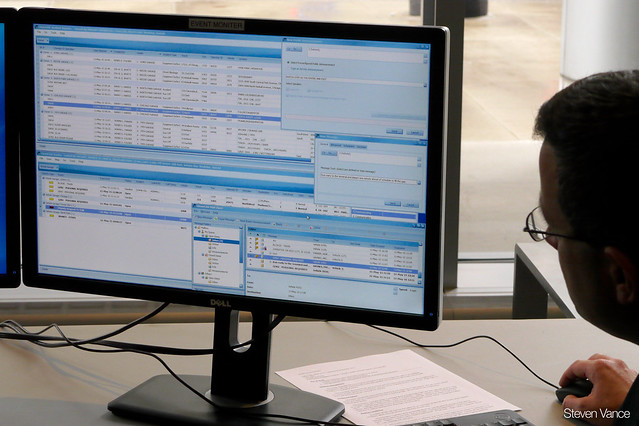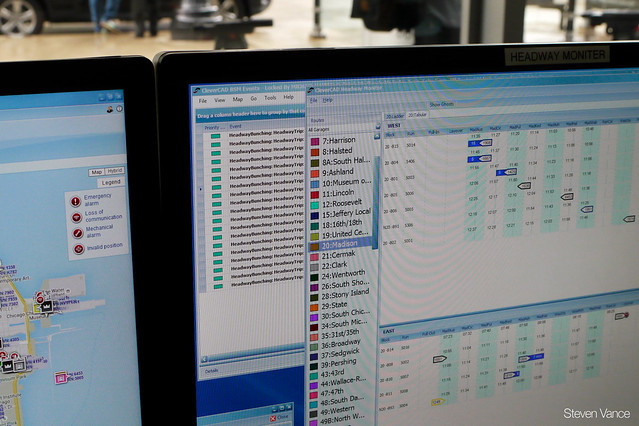
If you ride Chicago Transit Authority buses, you've probably had the infuriating experience of waiting an eternity at a stop, only to have two or more buses show up at the same time. This phenomenon, known as bus bunching, is the bane of most big-city transit systems in the U.S.
To address this issue, the CTA is rolling out a new two-way bus communication system, and it's already helping to reduce bunching on a handful of routes that have received the technology. The Bus Transit Management System, created by Clever Devices, the company that makes the CTA's Bus Tracker system, pairs an on-board device with new software at the transit agency's control center.
The software gives supervisors a heads-up when two buses are closer or further apart than they should be, and provides more information to help determine the best way to close the gap. If the supervisor wants more info from the bus driver – why they're behind schedule, for example – at the next stop, he or she can send a series of text messages that require "yes" or "no" responses from the driver. The text messages appear on a device installed at the top left corner of the bus' windshield.
Without the system, supervisors would continue having to drive around in their SUVs to see what's happening and then intervene by catching up to a bus driver and giving them instructions.
At a demonstration of the system on Monday at the agency's headquarters, CTA president Forrest Claypool said the technology is already making a difference in Chicago. Nine of the busiest South Side bus routes, based out of the 77th and 103rd Street garages, have seen a 40 percent reduction in "big gaps" between January and March. The agency defines big gaps as larger-than-scheduled periods of time between buses.
The new system gives supervisors several options for improving bus timing from the control center, according to CTA spokeswoman, Tammy Chase. The supervisor can order a driver to:
- Hold the bus back by waiting at a stop
- Run the bus express for a few stops
- Leapfrog a leading bus
- Temporarily follow a new route
"In some cases, an extra bus can be put into service to fill a big gap," Chase said. "The software allows us to identify small issues before they become big ones."
However, there's a limit to how effective this technology can be for fighting delays on typical CTA routes that lack dedicated bus lanes and have stops every eighth of a mile. "As traffic rises, even small, random events like a double-parked car can cause buses to lose time," DePaul transportation researcher Joseph Schwieterman told the Tribune. "That makes fixing the problem more difficult and it will test the limits of the technology."

Besides fighting bus bunching, BTMS is useful for a couple of other things. It allows control center staff to play prerecorded announcements on a bus' public address system. For example, if a supervisor has heard reports of icy conditions at an upcoming stop, he or she can have the bus' PA warn passengers to be careful as they disembark.
The system is also handy for locating items that passengers have left behind on buses. There was a real-life example of this on Tuesday. A customer who forgot her purse on a bus tweeted the CTA with the route and bus number, and supervisors used BTMS to ask the driver to look for the bag. Here's how things turned out:
@YoonA_4_ever Good news: We were able to reach the driver using the 2-way comms in our new bus mgmt system & they did find a bag! (1/2)
— cta (@cta) May 12, 2015
BTMS completely replaces the CTA's 15-year-old, "outmoded and less functional" Bus Emergency Communications System, so it's more than a simple technology upgrade, Chase said. The new, nearly $9 million system was funded by a federal grant. CTA is wrapping up the BTMS rollout and has already equipped over 80 percent of its bus fleet with the new tech.




